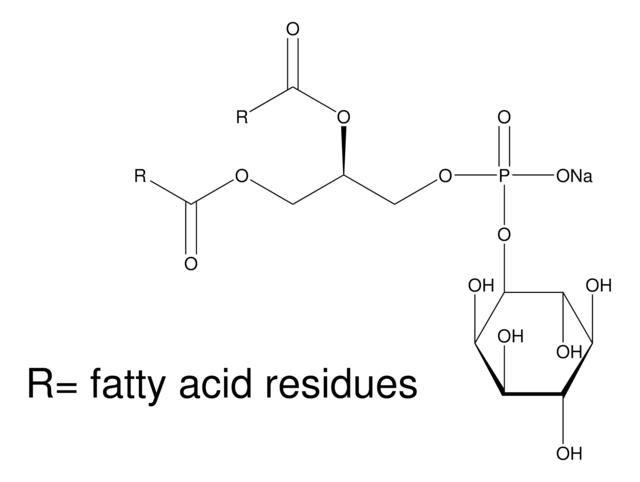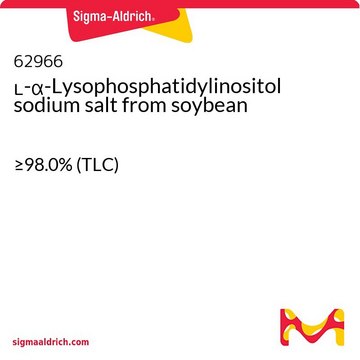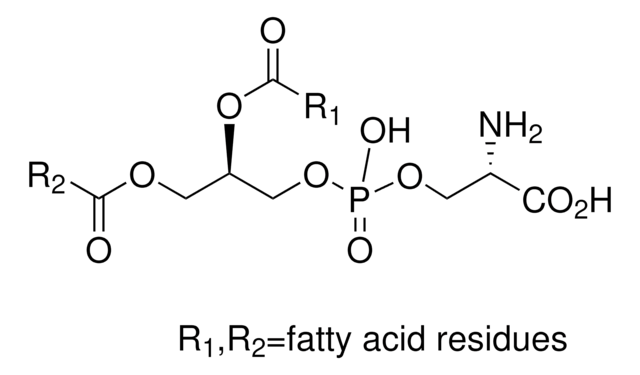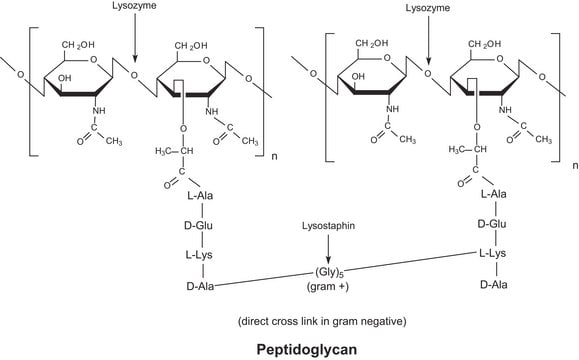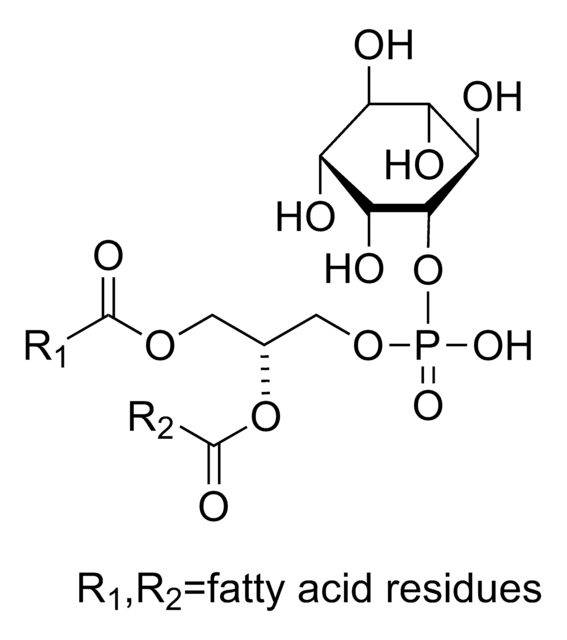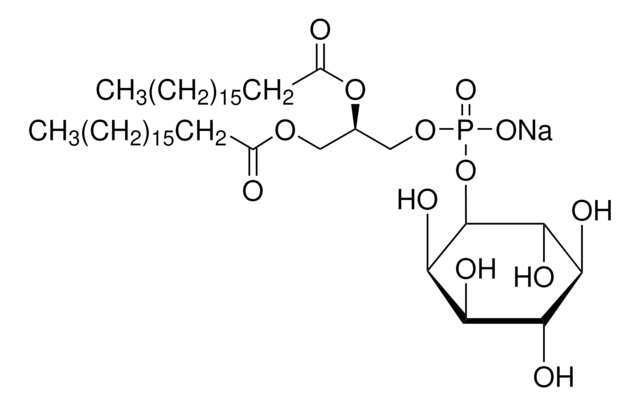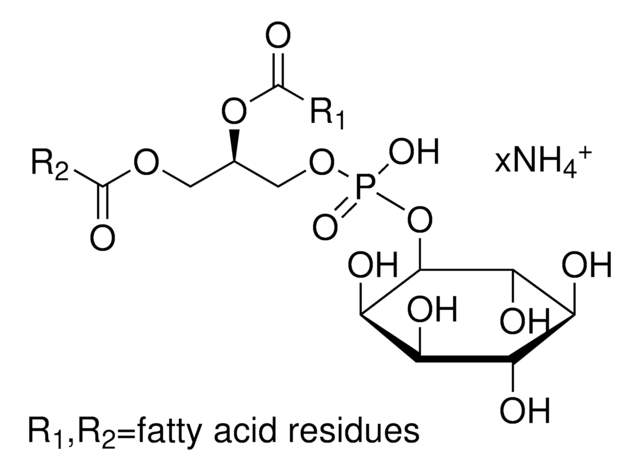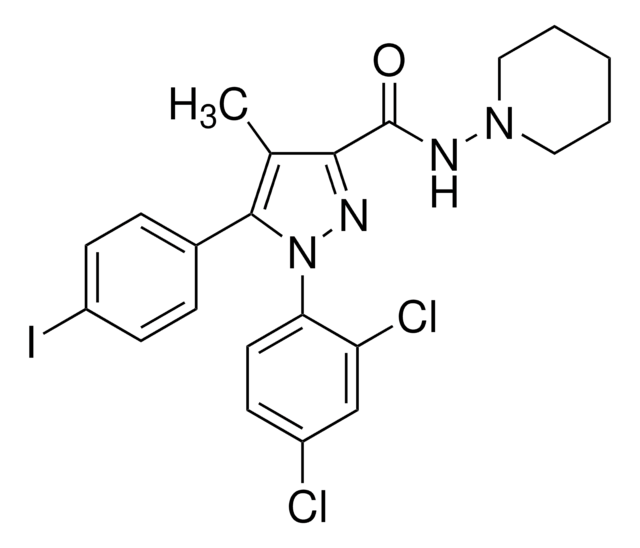L7635
L-α-Lysophosphatidylinositol sodium salt from Glycine max (soybean)
≥96%
Synonyme(s) :
1-Acyl-sn-glycero-3-phospho-(1-D-myo-inositol)
Se connecterpour consulter vos tarifs contractuels et ceux de votre entreprise/organisme
About This Item
Produits recommandés
Source biologique
soybean
Essai
≥96%
Forme
powder
Groupe fonctionnel
phospholipid
Type de lipide
phosphoglycerides
Conditions d'expédition
ambient
Température de stockage
−20°C
Application
L-α-Lysophosphatidylinositol sodium salt from Glycine max (soybean) has been used as an agonist of G protein-coupled receptor 55 (GPR55).
Actions biochimiques/physiologiques
L-α-Lysophosphatidylinositols (LPI) functions as an endogenous ligand for putative cannabinoid receptor and G protein-coupled receptor 55 (GPR55). LPI plays a regulatory role in cell proliferation, migration and function. Increased circulatory levels of LPI has been observed in the obese patients. In addition, overexpression of LPI leads to the development of various types of cancers including ovarian and breast cancer. LPI can be used as a potential diagnostic and prognostic biomarker for ovarian cancer.
L-α-Lysophosphatidylinositols from Glycine max (soybean) are enriched with stearate and palmitate. Soybean Lysophosphatidylinositols may be compared with other lysophosphatidylinositol for biological activities which depend upon the identity of the acylated fatty acid.
Qualité
Contains primarily palmitic and stearic acids.
Notes préparatoires
Prepared by the action of phospholipase A on L-α-phosphatidylinositol.
Code de la classe de stockage
11 - Combustible Solids
Classe de danger pour l'eau (WGK)
WGK 3
Point d'éclair (°F)
Not applicable
Point d'éclair (°C)
Not applicable
Équipement de protection individuelle
Eyeshields, Gloves, type N95 (US)
Faites votre choix parmi les versions les plus récentes :
Déjà en possession de ce produit ?
Retrouvez la documentation relative aux produits que vous avez récemment achetés dans la Bibliothèque de documents.
Les clients ont également consulté
Lysophosphatidylinositol stimulates [³⁵S]GTPγS binding in the rat prefrontal cortex and hippocampus.
Maria Luisa Rojo et al.
Neurochemical research, 37(5), 1037-1042 (2012-01-25)
Lysophosphatidylinositol (LPI) is a biologically active lipid that produces a number of responses in cultured cells, and has been suggested to have neuroprotective properties in vivo. Some of the actions of LPI are mediated by G-protein coupled receptors, but it
The L-alpha-lysophosphatidylinositol/GPR55 system and its potential role in human obesity
Moreno-Navarrete J, et al.
Diabetes, 61(2), 281-291 (2012)
The endocannabinoids anandamide and virodhamine modulate the activity of the candidate cannabinoid receptor GPR55
Sharir H, et al.
Journal of Neuroimmune Pharmacology, 7(4), 856-865 (2012)
Haleli Sharir et al.
Journal of neuroimmune pharmacology : the official journal of the Society on NeuroImmune Pharmacology, 7(4), 856-865 (2012-03-29)
The role of cannabinoid receptors in inflammation has been the topic of many research endeavors. Despite this effort, to date the involvement of the endocannabinoid system (ECS) in inflammation remains obscure. The ambiguity of cannabinoid involvement may be explained by
A novel biological role for the phospholipid lysophosphatidylinositol in nociceptive sensitization via activation of diverse G-protein signaling pathways in sensory nerves in vivo
Gangadharan V, et al.
Pain, 154(12) (2013)
Notre équipe de scientifiques dispose d'une expérience dans tous les secteurs de la recherche, notamment en sciences de la vie, science des matériaux, synthèse chimique, chromatographie, analyse et dans de nombreux autres domaines..
Contacter notre Service technique